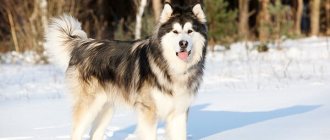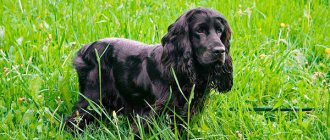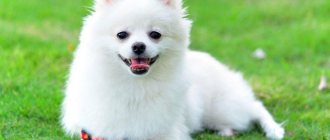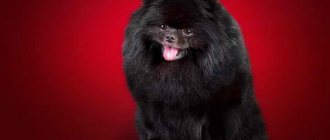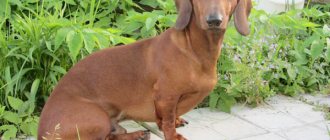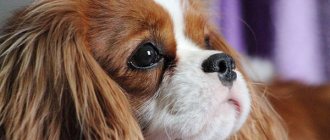Pomeranian Spitz or simply Pomeranians are decorative dogs with an incredibly attractive and pretty appearance.
Despite the fact that not all cynological associations recognize Pomeranians as an independent breed and consider them only a variety of German Spitz, these dogs are rapidly gaining popularity and winning the hearts of millions of dog breeders around the world.
In the article we will talk about what this dog breed looks like and what types there are.
Breed standard
An adult Pomeranian at the withers should be 18-22 cm. The weight of a dog to participate in the exhibition should be no less than 1.4 and no more than 3.2 kg, ideally 1.8-2.3 kg.
These dogs should have a dense, strong, but harmonious physique, a square body.
Breed standard:
- wedge-shaped head;
- the skull is small, tapering towards the nose, the stop is poorly defined;
- the muzzle is proportionate to the body, ratio 2:4;
- the nose is small, round, pigmented black or brown - depends on the color of the coat;
- the lips are weakly expressed, there are no folds in the corners of the mouth;
- straight or scissor bite, the absence of no more than 3 premolars is not considered a defect;
- cheekbones are rounded, not protruding;
- the eyes are small, almond-shaped, slightly slanted; the iris is black, and in individuals with brown fur it corresponds to its shade;
- the ears are triangular, pointed at the ends, set high and close, erect;
- croup short, straight;
- the chest is voluminous;
- the tail is bushy, set high and carried over the back;
- the forelimbs are straight, the shoulders are strong, with well-developed muscles;
- cat-type paws, rounded;
- the hind limbs are stocky and strong, set parallel;
- the skin fits tightly to the body, there are no folds.
Disadvantages for which participation in exhibitions is not prohibited include hereditary anatomical defects, an apple-shaped head and a too flat skull, large eyes, a lighter nose, and sudden movements.
NOTE!
Dogs with a crown that is not covered in time, an overshot or undershot eyelid, eversion or inversion of the eyelids, semi-erect ears, or obvious white spots in any color other than white cannot participate in exhibitions.
White shade
The white Pomeranian was bred in Japan and over time there are very few pure white dogs left. Breeders have difficulty producing such puppies, since they mostly appear white only at first glance. Cream colors often predominate.
In order for a white Pomeranian to be able to participate in the exhibition, its color must be snow-white. Yellow spots on the ears are a defect.
The white Spitz has the same situation as the black one - all ancestors must be of the same type, any other shade in the line of sires will easily give tan spots over time or the color of the puppy will become cream.
Owners who choose a white dog must be extremely neat and clean.
Character and temperament
The Pomeranian is a good-natured, affectionate pet who is interested in everything that surrounds him. These dogs are curious and will not refuse the opportunity to learn something new.
Representatives of this breed are characterized by a positive attitude towards life and irrepressible energy. Those who are used to leading a calm and sedentary lifestyle or simply do not have enough free time to communicate and exercise with their pet should not get these dogs - Pomeranians love active games and long walks.
They are very attached to the owner and easily adapt to his usual way of life - the pet will not wake up the owner in the early morning if he is used to sleeping for a long time, but as soon as he wakes up, the dog will follow on his heels.
Thanks to their sociability and ability to capture people's emotions, these dogs get along with all family members, including children - Pomeranians happily play with kids and become their best friends.
IMPORTANT!
Representatives of this breed are very fragile, so they should not be owned by families with children under 5-7 years of age - a child may inadvertently injure the dog.
Pomeranians are wary and suspicious of strangers and will always inform their owner about a stranger’s visit with a loud bark, which makes them good watchdogs. In addition, these dogs are fearless, so without hesitation they will rush to protect the owner if something threatens him.
It is important to raise a dog correctly and from an early age, immediately showing it who is in charge in the house. Pomeranians tend to be dominant, which can become a problem as the pet grows up.
Living decoration
The Pomeranian breed has come a difficult way from northern sled dogs to favorites of the aristocracy. Sable color is a “living decoration”. And it doesn’t matter which color you like: delicate cream, calm gray or fiery red. Any of the oranges attracts attention and pleases the eye.
The Pomeranian is an intelligent, beautiful and charming dog with a very complex character. This breed is not recommended for beginning breeders. And it's not about the difficulty of care. A creamy and fluffy pet with a cute face is able to conquer the whole family and make everyone revolve around the “royal” person.
What types are there?
There are 3 varieties of the Pomeranian breed, which differ from each other in the structure of the muzzle.
At the same time, those who are thinking about buying such a dog should understand that only type 1 , while other types, despite their attractive appearance and the absence of other differences, can only be pets - they are not allowed to participate in exhibitions.
NOTE!
It is possible to determine what type the puppy is only when he is 3-4 months old.
Fox
It is with this type name that the Orange Spitz meets the breed standard adopted by the American Kennel Club. These dogs have an elongated, fox-like muzzle, fluffy cheeks, almond-shaped eyes, a narrow lower jaw, a small nose and a longer tail than the bear type.
These Pomeranians can be confused with the classic German Spitz, but the “fox cubs” have shorter fur and longer paws.
Despite the fact that these puppies are purebred and have more prospects in breeding and at exhibitions, their cost is lower than for other types of dogs. This is due to the low demand for them, since many consider them less attractive.
Bearish
This variety is the most popular. Small ears, plump due to the thick hair on the cheekbones, a short muzzle, a nose located slightly higher than that of the fox type, and small ears make these dogs look like small bear cubs.
They have a very thick coat, but less long in comparison with other types, and an undercoat developed thanks to the perpendicular outer hairs.
Unfortunately, the desire of breeders and breeders to comply with fashion trends and breed popular “bear cubs” has a negative impact on the breed as a whole.
The problem is that extremely short muzzles are the cause of many diseases in such dogs, including tracheal collapse, heart pathologies, syringomyelia and others. Bear-type Pomeranians have poor health and a shorter lifespan.
For this reason, many kennels that care about the health of the breed do not breed this type of dog.
Toy
The toy type owes its appearance to the Japanese, who became interested in the white coat color of Pomeranians. It is impossible to determine whether it is a real dog or not by taking a quick glance at it.
These dogs have an even shorter muzzle than the “bear cubs”, but in the latter it is not flat, but rounded. The eyes of “toy” Spitz dogs are set a little higher and further apart.
Wolfspitz (Keeshond or wolf dog)
Another name, Barge Dog, appeared because of the dog’s purpose: accompanying sailors at the crossing to protect supplies from rodents. The breed was born in Holland from the German Spitz, and for a long time was a symbol of the rebel patriotic organization in the Netherlands.
It is no coincidence that Spitz is named Wolf. This dog is the most original in color: gray-black coat, black glasses, contrasting white and black stripes. The shape of the body, skull, muzzle and limbs completely coincides with its neighbors in the group and section (European Spitz). They grow up to 48 cm at the withers.
These are family dogs, they quickly become attached to their owners, and feel incredible sadness from parting. Keeshonds adore children, pets, people around them (even strangers), but they sense danger and can warn household members. They show good results in their work, are obedient and resilient, can train for a long time, and quickly grasp commands. The average cost of a Wolfspitz is 30 thousand rubles.
Photos of the main colors
Pomeranians can come in a variety of colors.
In accordance with the classification of the American Kennel Club, they are divided into 3 large groups:
- black, brown and zone gray;
- red, cream, sable;
- other colors.
IMPORTANT!
The final color of the Pomeranian's coat is formed after the first molt and may differ from what it was at birth.
Ginger
The most common color. Any intensity of red shade is acceptable, as well as lighter hair on the “pants”, muzzle, ears and tip of the tail.
The presence of brown color is unacceptable; the predominance of white hairs is considered defective.
In puppies, the guard hair may be light orange and the undercoat gray.
Cream or beige
The standard does not list acceptable shades, so dogs with cream coat of any intensity and shade are allowed to participate in the exhibition.
In general, cream color is divided into rich (warm) and cold, which visually looks white, but has a beige tint.
The coat of such puppies at birth can be white, beige, or even white with splashes of yellow.
Black
The coat is a solid glossy black color. It is noteworthy that in such dogs the skin, lips, nose and undercoat should also be black.
Puppies' fur may be brown or dark gray.
If a puppy born from completely black parents has small light hairs on the undercoat, this is not considered a serious defect and a violation of the standard. The disadvantage is also early gray hair in the muzzle area and slight fading of the undercoat.
Large spots of white or some other color are considered a significant defect.
To ensure that the color of the dog’s coat does not change after molting, it is necessary to ensure that there are no dogs of a different color in the family tree.
White
Pomeranians with a completely white coat are not albino, but leucistic - their nose, lips, eyes and skin are colored.
White is the main color of oranges, but it is not easy to achieve.
Most often, the coat is not snow-white, but has a creamy tint. Absolutely white dogs can only be born from the same parents. It is also important that their ancestors in the family tree are also white, otherwise later generations may develop some coloration.
According to the standard, any, even the slightest colored inclusions or spots of yellow color are considered defective.
Sable
This color belongs to the zonal color and consists of 2 colors: the undercoat is an iridescent light tone, and the guard hairs at the tips can be of different shades - from red and creamy sand to rich dark gray. It is important that the color of the muzzle and ears be identical.
Color can be of 3 varieties:
- red sable;
- creamy sable;
- gray sable.
Blue
Blue is a rare and expensive color.
The coat of blue Spitz dogs is evenly colored gray of varying intensity with a smoky tint.
Zone gray
This color is also called wolf color. It is quite rare in Pomeranians and is prized by breeders.
With this color, the coat has a grayish color with a silver tint, the eyes are clearly outlined, the ears are colored dark, and the muzzle is a rich grayish tint, the tail is black at the tip, the undercoat is whitish, the hair on the forearms and feathers is light.
Puppies are born almost black, but with age they lighten and the undercoat becomes thicker.
Brown or chocolate
Brown (chocolate) oranges do not have the pigment that makes their coat black, so its color matches the color of the nose, lips and eyelids. Of particular value are dogs that have a rich chocolate color.
After shedding, dogs' coat color does not change, but as they mature, light hairs may appear on the undercoat.
Origin story
The Pomeranian Spitz breed was developed in Germany, in the Pomerania region, hence the name of the breed. The first Pomeranians are much larger than the current ones, they weighed about 15-20 kg and were used as guard dogs. Their color was white.
In the 19th century, Pomeranian Spitz had already appeared in Russia; they were brought to us from Germany and England. At that time, Spitz were considered an elite breed and only rich representatives of the classes could afford them. Pomeranians were an adornment for beautiful ladies. Gradually, various variations of the breed began to be developed. The dogs differed in size, type, and color. As a result of long breeding, new colors began to appear: red, cream, peach, black.
And later, Spitz dogs turned from large guard dogs into small, decorative dogs. In character, they remained like their ancestors, brave, ready to defend their master to the end.
Size varieties
The breed standard specifies the optimal weight for adult representatives of this breed. Thus, the English and American Kennel Clubs consider the standard weight to be from 1.36 to 3.1 kg. On average, the body weight of males should be 1.8-2.3 kg, females - 1.4-3 kg.
Depending on the final weight, representatives of this breed are divided into 3 groups:
- tiny sizes – 1-2 kg;
- tiny toe sizes – 2.25-3.0 kg;
- tou sizes – 3.25-3.5 kg.
Some individuals stop gaining weight before even reaching 1.36 kg. Such miniature dogs require special conditions of maintenance and care.
Finnish Spitz
A breed with an unusual, complicated history of origin. Dogs appeared in the north, they were first found between Finland and Karelia, some individuals continued to be bred in Finka, the rest were taken by Russia. And so it happened - 2 livestock in the same standard, slightly different in appearance and character. Now the world knows the Finnish Spitz and the Karelo-Finnish Laika.
Universal hunting dog: fur, ungulates, upland game, bear, small rodents. Karelians can both earn food for themselves and help their owner. In northern conditions, they get along well in yurts, warm children, and guard the house. Very close to the owner, but shy away from strangers, not loving, but kind and flexible.
The main drawback of the breed is arrogance. Animals consider themselves the most important, so they often do not accept their owners and can run away. They are accustomed to freedom and will not obey a person who does not show his leadership.
In general, the dogs are similar to the Spitz - a square body, coarse hair, a fluffy donut tail, a wedge-shaped head, a fox-like squint and a narrow muzzle. The peculiarity of the species is its bright red color. Karelians grow up to 50 cm, among Laikas they are the smallest. The average cost of puppies is 22-26 thousand rubles.
Each Spitz has its own temperament and habits. The owner should choose a future pet based on similarity in character. You need to accept in advance that the animal sheds actively all year round and requires increased attention and special care measures: from special nutrition to daily brushing, walks and training.
3.1 / 5 ( 426 votes)
Are boys different from girls?
There are no significant differences in the exterior of Pomeranian females and males - both must be compact in size, have a thick coat and generally comply with the official breed standard.
However, it is believed that the judges' preference at the show will be given to male dogs, since they have a more impressive appearance, look larger and have a longer and more voluminous coat.
Rare colors
Blue
Blue is the most unusual color for Spitz. Its varieties - colors called blue merle and blue merle - are very rare and highly prized. What all these variations have in common is that they are based on the color grey. The rarest merle color is dominated by the merle gene and produces a combination of light blue areas of the coat and rich gray areas that look blue.
It is important to know that puppies of this color can be born with a number of genetic diseases, be blind and deaf. Russian standards do not recognize this color, but nevertheless, many breeders keep animals of this color, since it has big fans - wealthy people who buy Spitz not for breeding, but for the soul.
Marble
Among the marble tinting options you can find the following:
- marble black;
- brown marble;
- orange-sable marble;
- orange-blue marble;
- lilac marble.
What do the puppies look like?
During 1 year of life, the appearance of Pomeranian Spitz undergoes significant changes, which every owner of such a dog should be aware of.
Up to 1 month
Puppies are born weighing 55-125 g, they have no hearing or vision, they are absolutely defenseless and very vulnerable. The body of such babies is disproportionate: the head is large and compressed, the body is elongated, the stomach is voluminous, and the legs are short. The body is covered with faint down, through which the skin is visible; its color indicates what shade the dog's coat will be.
Blueness is a sign of the presence of any pathologies.
About 2 weeks after birth, puppies' eyes open, and at 17-21 days, their ear canals open. At the beginning of the 3rd week, babies can empty their bowels on their own, and at the end of 1 month they stand well on their paws and move actively.
Up to 2 months
At 3 weeks after birth, puppies begin teething, causing their gums to become swollen and itchy. Little Pomeranians behave restlessly.
The period from 4 to 8 weeks after birth is associated with laying the foundations of the dog’s behavior and character; at the end of 2 months they are ready to move to a new home.
3 month
The so-called baby or puppy hair begins to be replaced by an adult one. You can already determine the color of the dog.
4-5 month
At this age, puppies do not look very attractive - new hair grows gradually, which is why they seem to be not fully dressed. At the same time, the replacement of milk teeth with molars occurs.
The body of Pomeranians acquires the proportions characteristic of the breed.
6-9 month
Shedding is still ongoing, the change of teeth ends by the 7th month. In some individuals, the molars grow next to the lost milk teeth, which in such a situation must be removed at the veterinary clinic.
At 8 months, Pomeranians can already participate in their first show.
1 year
In bitches, at 9-12 months, puberty begins and the first heat begins. Another molt is taking place. The Pomeranian coat acquires its final appearance by the age of 3 years.
CAREFULLY!
You cannot breed a dog during its first heat. This will negatively affect her health.
Why does color matter?
When choosing a dog, we look for a breed that suits our lifestyle and fits into our home environment. The color of the animal is not the main selection criterion, but still has special significance.
The appearance of a Spitz (or any other creature) depends on the resulting set of genes. They are responsible for the color of the animal, as well as hereditary traits, both good and bad.
When purchasing a small Spitz, take an interest in the dog's heredity. If she had undesirably colored relatives, the animal may have genetic diseases. If the errors in color were insignificant, the puppy may well become your friend, but not a participant in the rings.
If you want to breed Spitz dogs and participate in shows, study the puppy’s pedigree thoroughly so that you don’t get any surprises later. Babies, when they shed their baby fur, are able to change color.
How to choose your future pet?
It is best to purchase a puppy in a specialized nursery from trusted breeders who value their reputation - this will eliminate the possibility of buying a purebred or sick pet.
It is important to inspect the living conditions of the dogs, meet the puppy’s parents, find out about their health and titles if we are talking about buying a breed or show-class pet.
It is also necessary to carefully examine the puppy itself. In a healthy standard dog:
- shiny coat without bald patches and dandruff;
- clean skin without rashes, inflammation and scratch marks;
- there is no increased lacrimation, discharge from the nose and eyes;
- ears are clean, without unpleasant odor;
- pink mucous membranes;
- not bloated belly;
- scissor or straight bite.
The puppy must be active, cheerful and inquisitive; aggression is unacceptable.
Reference! The size of the puppy should not determine the choice - even the smallest pet can grow up to be a large dog.
You should also decide in advance about the gender of the dog - its character largely depends on this. So, males are more stubborn and independent, while females are more obedient, more affectionate, and easier to train. In addition, if there are plans for the pet to participate in breeding the breed, then the choice should be a girl.
Contents in the apartment
The modest size of the Pomeranian allows it to be kept even in a small apartment. Before purchasing “Soft Joy,” you need to prepare not only the place, but the entire room. Small items from the floor, shoes, household chemicals, building materials - move them to a closet with a securely closing door. Remove rugs and carpets until the tray turns orange. Blocks access to cables and hazardous household chemicals. If the puppy is left at home alone, you can arrange a small enclosure for him. This is a reliable way to protect the environment from a playful child and the dog itself from harm.
Of course, there will be difficulties when breeding an orange, but this is true for any breed. And dogs are undemanding in care. They rarely get sick (if there are no hereditary diseases), take care of their fur like cats, and are unpretentious in food. In addition to training, feeding and walking, the owner must regularly comb the orange's long and thick fur.
Disqualifying faults
RKF admitted a number of serious violations that will lead to disqualification from the exhibition event. These include spots on the coat of any color other than white. The presence of white marks on the tips of the legs or chest is not a fundamental reason to disqualify an animal.
An equally serious violation is a black nose in any type of Spitz except chocolate. The brown one may have a nose that matches the color of the fur.
If the exhibition is held in winter, a lighter nose on an orange, beige or cream Spitz is not considered a disqualifying fault. This is due to the fact that in winter their nose always becomes lighter.
Owner reviews
Our dream of having a Pomeranian in the house came true two years ago. A handsome red-chestnut Barry, bred by American breeders, appeared in the apartment. He is of the bear type, so he never ceases to touch even in adulthood, and his fur color changes depending on the lighting.
We bought a puppy for exhibitions, we couldn’t wait until four months to make sure of its pure snow-white fur, and look further into the pedigree than mom and dad hadn’t guessed. As a result, we cannot participate in exhibitions because disqualifying spots have appeared. At first it was offensive, but then they calmed down. We still love our little bundle.



